
Soft and fluffy Bhatura is a delicious fried bread widely enjoyed in Indian cuisine. This classic side dish comes in various forms but is usually made with a leavened dough of all-purpose flour, semolina, yogurt, water, salt, sugar and a leavening ingredient like baking soda, baking powder or yeast. Here, I present a simple, no-yeast instant and quick recipe for Bhature (plural), complete with step-by-step pictures and detailed instructions.
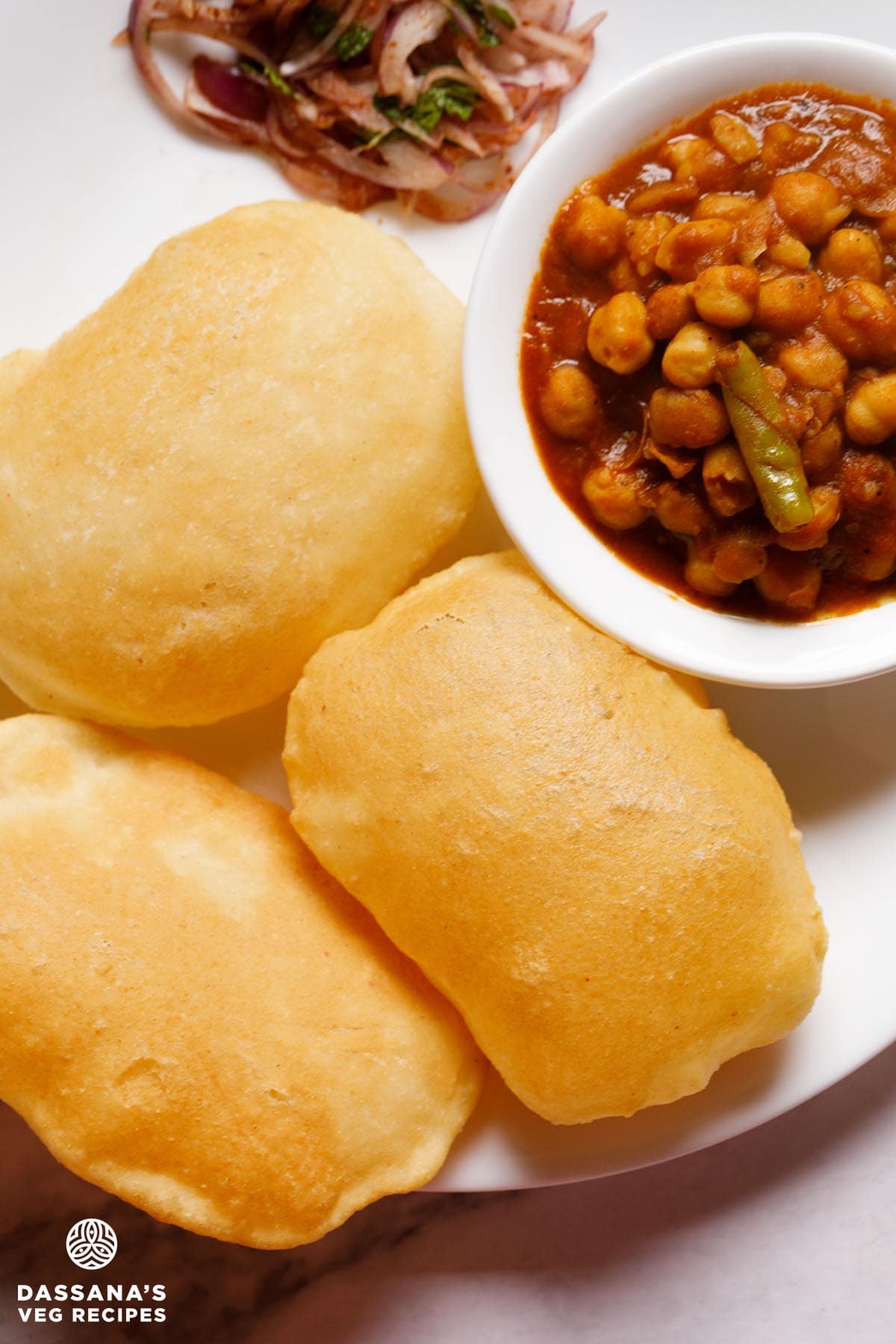

About Bhatura Recipe
A plate of warm, fluffy bhatura is a must-have whenever we indulge in our favorite Punjabi dishes like Chole Masala. This beloved combination, known as Chole Bhature, is incredibly popular. You’ll also find these crispy, golden fried breads at nearly every street food stall in India.
Bhatura is traditionally made with all-purpose flour. To make it crispy, some suji/rava (cream of wheat) is added together with yogurt for a slightly sour taste.
To achieve the signature puffiness of Bhature, a leavening agent is always used. This can be a natural fermenting agent like a sourdough starter, yeast or an instant rising agent such as baking soda or baking powder or fruit salt (eno) and even drinking soda (sparkling water).
In this post, I’m sharing a quick and easy method for making Bhatura without yeast. This instant recipe uses baking soda and baking powder to help the dough rise, along with yogurt for fermentation.
The dough requires just 2 hours to leaven, making the process much faster. The reaction between the baking soda, baking powder and yogurt (curd) results in a fried bread that is light, soft and beautifully puffed.
This recipe yields soft, fluffy and flavorful Bhature without any overly sour taste. After the 2-hour fermentation, you can roll and deep-fry the dough while preparing your favorite chickpea curry to pair with it.
The Bhatura is made with all-purpose flour (maida) and fine semolina (sooji or rava). I have also tried substituting semolina with rice flour, and both versions taste great. The rice flour variation remains softer even after cooling.
As mentioned earlier, baking soda, baking powder and yogurt serve as leavening agents. Adding both the baking soda and baking powder ensures that the bread does not have the typical soapy aroma which occurs if you only add baking soda and a metallic after-taste if you only add more of the baking powder.
Step-by-Step Guide
How to make Bhatura
1. First sift the following ingredients in a mixing bowl:
- 1½ cups all-purpose flour (maida)
- ½ teaspoon salt
- ¼ teaspoon baking soda
- ½ teaspoon baking powder
Once the above ingredients are sieved, add 7 tablespoons rava or fine sooji (semolina) and 1 tablespoon sugar in the same bowl.
Mix these dry ingredients evenly with a spoon
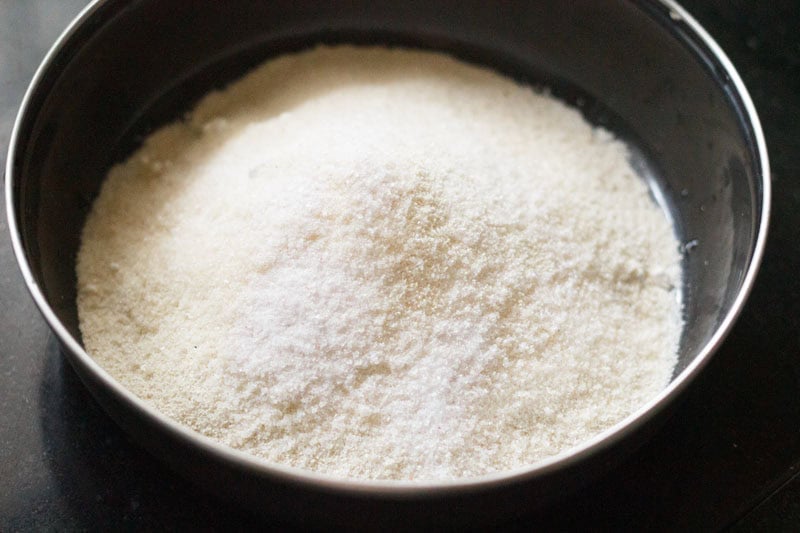

2. Add ½ cup yogurt (curd) and 2 tablespoons oil. Mix thoroughly with a spoon.
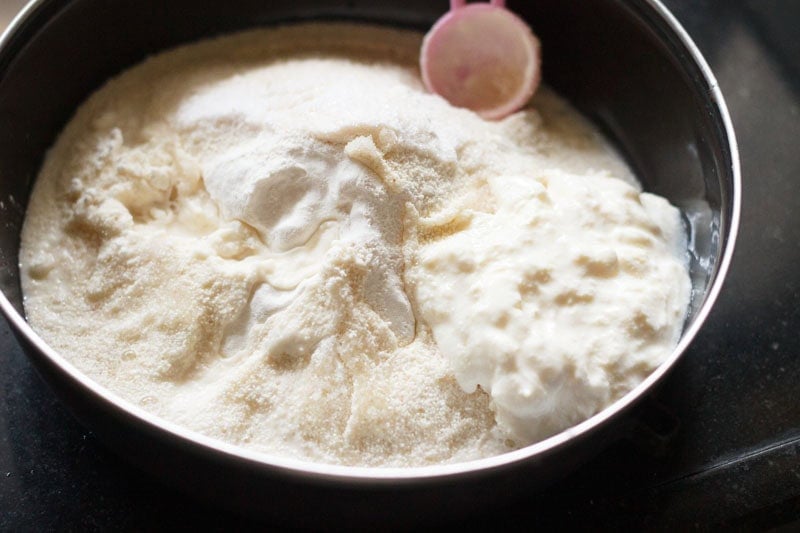

3. Add about ½ tablespoon water at a time. Mix and then knead to a smooth, supple and soft dough. Make sure the dough is not sticky.
You will need to add a total of 3 to 4 tablespoons water, or as required to get the right consistency and texture in the dough.
If it looks sticky, sprinkle a few tablespoons of flour and continue to knead. If the dough looks dry or floury, add little water and knead.
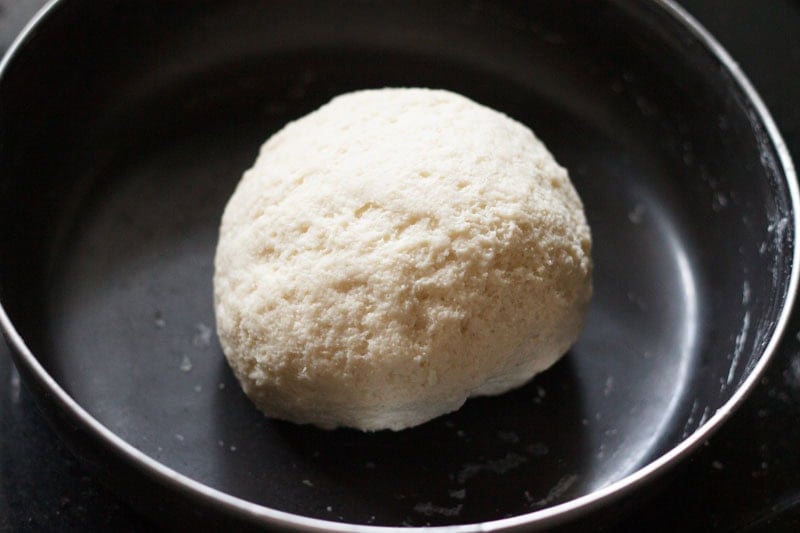

4. Cover the dough with a wet cotton napkin and set aside the dough to leaven for 30 to 45 minutes. You could even keep it for about 1 hour to 2 hours.
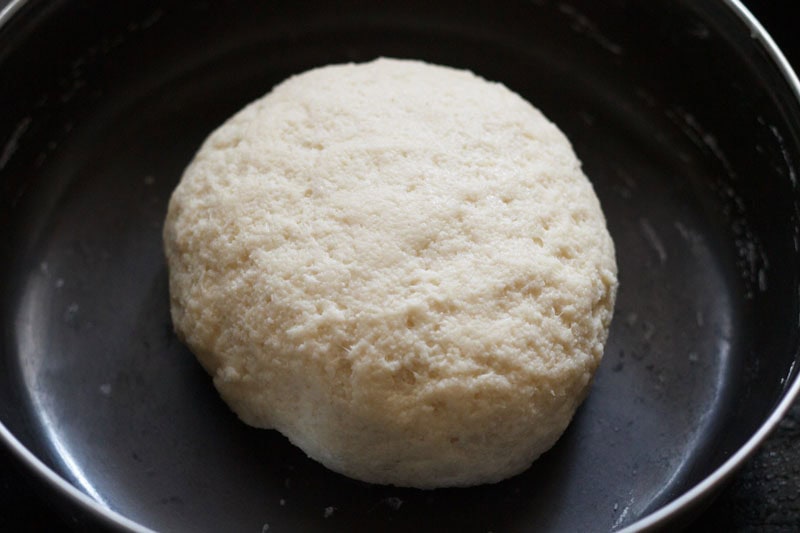

5. Before you begin rolling and frying, heat oil as needed for deep frying in a kadai (wok). Keep the heat to medium or medium-high.
Make medium-sized balls from the dough. Apply oil to the dough ball on both sides.
Using a rolling pin, roll into an oval or elongated shape ensuring that the edges are about 2 to 3 mm thick.
Remember to roll the dough evenly without making the edges thin. An unevenly rolled dough won’t puff up uniformly.
You could make either larger or medium-sized bhatura. If you choose to make larger bhature you will need to use bigger dough balls. However this will yield fewer bhature from the recipe.
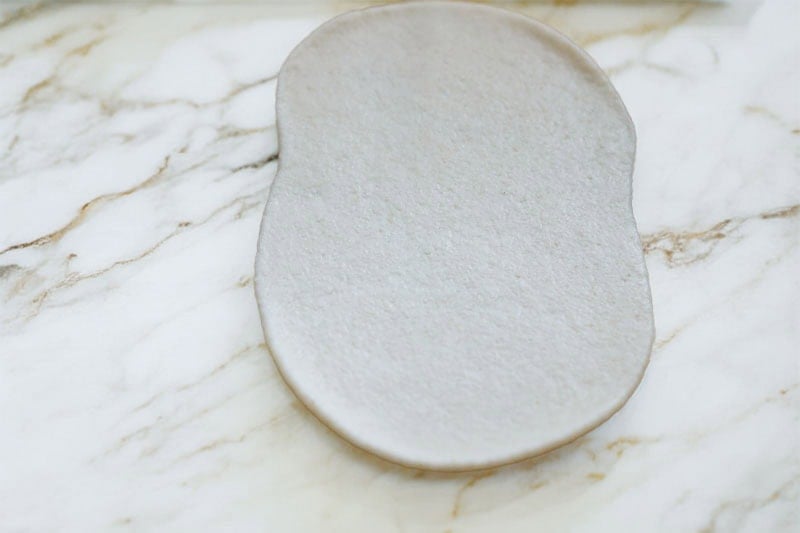

6. Drop the rolled dough in hot oil and it will start puffing within a minute. Fry on medium to medium-high heat.
Use a slotted spoon for frying and gently nudge the rolled dough to help it puff evenly.
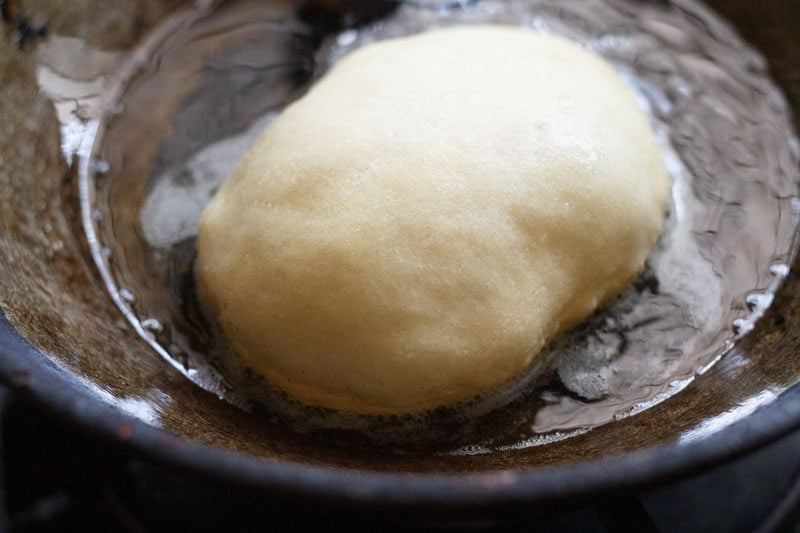

7. When the sizzling of the oil stops and the bhatura turns a light golden or golden, turn over and fry the other side.
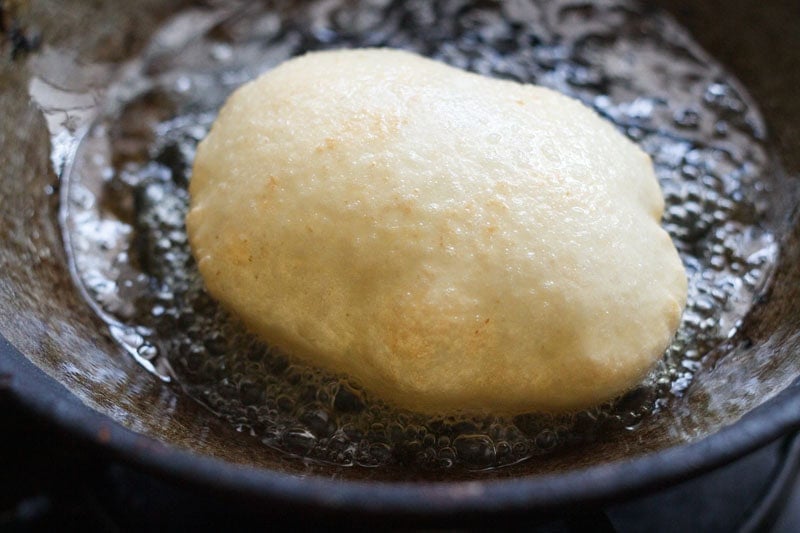

8. When the second side is light golden or golden using a slotted spoon remove the bhatura. Place it on paper towels to remove excess oil.
Fry all Bhature this way in batches.
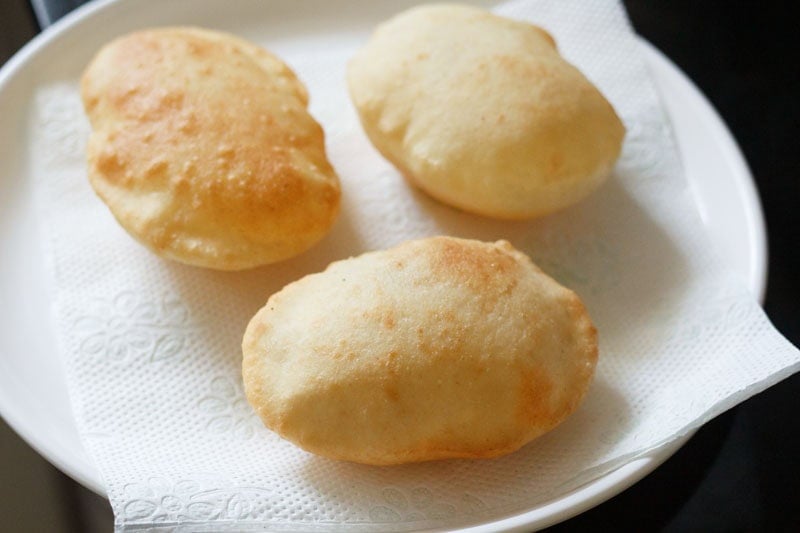

9. Serve Bhatura hot with Chana Masala or your favorite chickpea curry. Bhature tend to be chewy once cooled, so it is best to enjoy them while still hot.
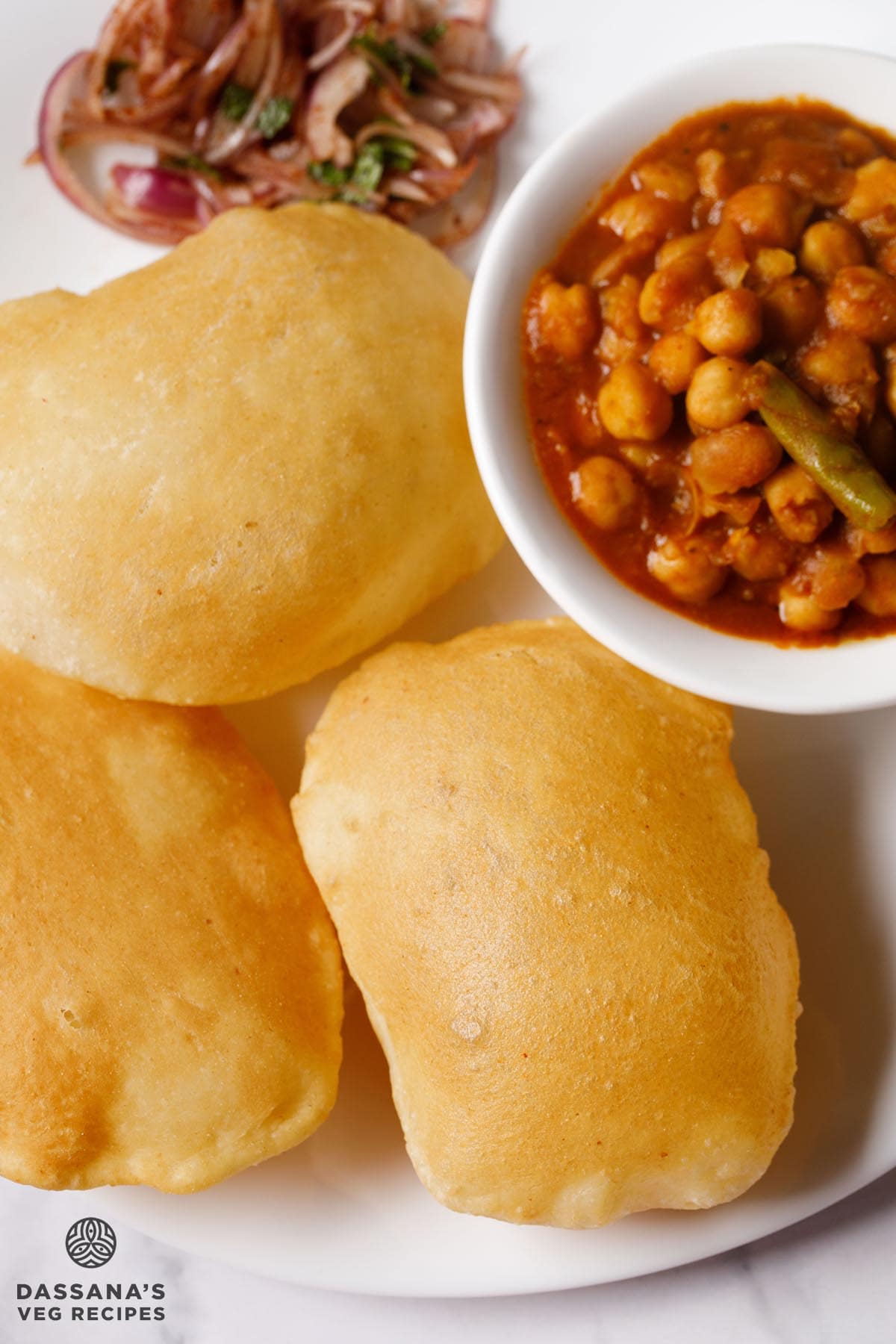

Expert Tips
- Using blend of flours: While all-purpose flour (maida) is traditionally used, adding a small portion of semolina (sooji) or rice flour can enhance the crispness while keeping the Bhatura soft inside.
- Adding sugar: Some sugar enhances fermentation and gives the Bhatura a slight golden color when fried. It also balances flavors subtly.
- Resting dough: To speed up fermentation, keep the dough in a warm spot (like inside a microwave or oven with the light on). This helps the baking soda and curd react better, making the Bhatura airy and fluffy.
- Rolling Bhatura: When rolling, don’t apply too much pressure – gently roll to maintain air pockets. This helps the Bhatura puff up evenly when fried.
- Frying Bhature: The oil should be medium-hot. If the oil is too hot, the Bhatura will brown quickly but remain raw inside; if too cold, they will absorb too much oil and turn greasy.
- Additional flavors: Since Bhature is deep-fried, adding ¼ teaspoon ajwain (carom seeds) or crushed fennel seeds makes them easier to digest while enhancing flavor.
FAQs
If the dough is too sticky, sprinkle a little more all-purpose flour (maida) and knead again until it becomes smooth and soft. However, avoid adding too much flour, as it can make the Bhature dense. Lightly greasing your hands with oil while kneading can also help handle sticky dough.
While technically you can substitute baking soda with baking powder, but you’ll need add to 3 times more, which is a total of 1¼ teaspoon in this recipe. This much quantity of baking powder, may result in a metallic after taste which is not pleasant.
Baking soda (sodium bicarbonate) is a pure alkaline substance that needs an acidic ingredient (like yogurt or lemon juice) to activate it and produce gas for leavening.
Baking powder includes baking soda together with an acidic component, so it can work on its own without additional acids. It provides a slower, more controlled rise compared to baking soda.
Yogurt acts as a natural leavening agent, working with baking soda to leaven the dough, making the Bhature light, soft and puffy. It also adds a slight tangy flavor and helps improve the texture, preventing the bhature from becoming too chewy or dense.
More Indian Fried Breads To Try!
Please be sure to rate the recipe in the recipe card or leave a comment below if you have made it. For more vegetarian inspirations, Sign Up for my emails or follow me on Instagram, Youtube, Facebook, Pinterest or Twitter.
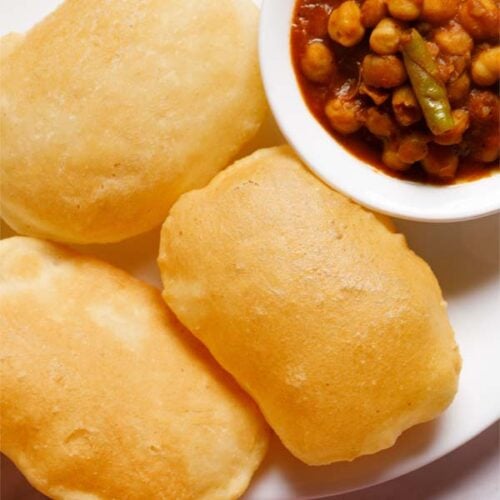

Bhatura Recipe (Quick Bhature)
Bhatura (or Bhature) is a crispy, fluffy, fried North Indian bread made with a leavened dough of all-purpose flour, yogurt, water, salt, sugar and a leavening ingredient like baking soda, baking powder or yeast. This soft & fluffy no yeast Bhatura recipe is made with a leavened dough of all-purpose flour, yogurt, oil, sugar, baking powder and baking soda. This is an easy, quick recipe to make these crispy as well as soft fried bread which is always served with Chana Masala.
Prep Time 2 hours 10 minutes
Cook Time 20 minutes
Total Time 2 hours 30 minutes
Prevent your screen from going dark while making the recipe
Making Bhatura Dough
Sift the all-purpose flour with baking powder, baking soda and salt in a mixing bowl.
Add the sooji and sugar. Mix thoroughly.
Add the yogurt, oil and mix again with a spoon
Add very little water bit by bit (just about ½ tablespoon at a time) and begin to knead.
Knead the dough, adding water as needed.
Form into a smooth, supple and soft dough.
Cover the dough with a moist cotton napkin and let the dough leaven for 30 to 45 minutes at room temperature.
Making Bhatura
Heat oil in a kadai or pan for deep frying.
Make medium-sized balls from the dough.
Roll the balls between your palms to make them even.
Keep the balls covered with the damp kitchen napkin.
Take a ball and flatten them slightly. Apply oil on both sides and with a rolling pin, roll the ball into oval or elongated shape making sure the edges are about 2 to 3 mm thick.
Make neither thick nor thin bhature.
Rotate the rolling board while rolling the bhature as it much easier than lifting it, since we are not using flour to roll them.
When the oil is hot enough, place the rolled dough gently into the oil. It will puff up.
Aid in puffing by applying light pressure on it with a slotted spoon.
When the oil stops sizzling and the bhatura turns light golden, turn oven and fry the second side.
When light golden, remove and drain on kitchen paper towels to remove excess oil.
Make the rest of the bhature this way. Serve the bhatura hot with chana masala.
- Ensure to use suji (rava) as it helps to get a slightly crispy texture.
- Additionally make sure to use both the baking soda and baking powder in combination.
- The dough can be rested for about 30 to 45 minutes or up to 2 hours. Keep it covered with a moist damp cloth to prevent drying.
- The oil should be moderately hot, but not smoking hot. If the oil is too hot, the bhatura will brown quickly but will be undercooked inside. If the oil is cold or warm, the bhature will absorb more oil.
- Fry the bhatura one at a time, so that it puffs up evenly.
- You could add ½ cup rice flour instead of rava or sooji.
- The nutrition information is for 1 bhatura.
Nutrition Facts
Bhatura Recipe (Quick Bhature)
Amount Per Serving
Calories 162 Calories from Fat 45
% Daily Value*
Fat 5g8%
Saturated Fat 1g6%
Cholesterol 2mg1%
Sodium 196mg9%
Potassium 60mg2%
Carbohydrates 25g8%
Fiber 1g4%
Sugar 2g2%
Protein 4g8%
Vitamin A 15IU0%
Vitamin B1 (Thiamine) 1mg67%
Vitamin B2 (Riboflavin) 1mg59%
Vitamin B3 (Niacin) 2mg10%
Vitamin B6 1mg50%
Vitamin B12 1µg17%
Vitamin E 2mg13%
Vitamin K 1µg1%
Calcium 73mg7%
Vitamin B9 (Folate) 53µg13%
Iron 3mg17%
Magnesium 10mg3%
Phosphorus 58mg6%
Zinc 1mg7%
* Percent Daily Values are based on a 2000 calorie diet.
Bhatura recipe from the archives was first published on April 2013.

Source link